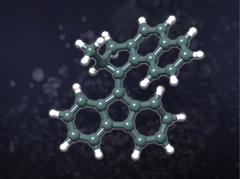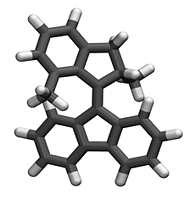URL: https://www.desy.de/news/news_search/index_eng.html
Breadcrumb Navigation
DESY News: Microwaves reveal detailed structure of molecular motor
News
News from the DESY research centre
Microwaves reveal detailed structure of molecular motor
A team of scientists has used microwaves to unravel the exact structure of a tiny molecular motor. The nano-machine consists of just a single molecule, made up of 27 carbon and 20 hydrogen atoms (C27H20). Like a macroscopic motor it has a stator and a rotor, connected by an axle. The analysis reveals just how the individual parts of the motor are constructed and arranged with respect to each other. The team led by DESY Leading Scientist Melanie Schnell reports the results in the journal Angewandte Chemie International Edition.

The molecular motor under investigation. Credit: Sérgio Domingos, DESY
“The functional performance of such nano-machines clearly emerges from their unique structural properties,” the authors write in their study. “To better understand and optimise molecular machinery it is important to know their detailed structure and how this structure changes during key mechanical steps, preferably under conditions in which the system is not perturbed by external influences.”
The rotary motor investigated here holds great promise for quite a few applications, as first author Sérgio Domingos from DESY and the Max Planck Institute for the Structure and Dynamics of Matter (MPSD) explains: “Chemists are all abuzz about this molecule and try to connect it with a range of other molecules.” When activated by light, the nano-machine operates through consecutive photochemical and thermal steps, completing a half turn. A second trigger then forces the motor into completing a full turn, returning to its starting position.

The atomic make-up of the motor molecule had been investigated before with X-rays. For the X-ray analysis the molecules had to be grown into crystals first. The crystals then diffract the X-rays in a characteristic way, and from the resulting diffraction pattern the arrangement of atoms can be calculated. “In contrast, we investigated free floating, isolated molecules in a gas,” explains Schnell, who works at the Center for Free-Electron Laser Science (CFEL), a cooperation between DESY, the University of Hamburg and the Max Planck Society. “This way we can see the molecule as it is, free from any external influences like solvents or bindings.”
In order to determine their structure, the free-floating molecules had to be exposed to a resonant microwave field. “We used an electromagnetic field to orient the molecules all in the same direction in a coherent way and then recorded their relaxation when the field is switched off,” explains Schnell, who also leads a research group at MPSD and is a professor for physical chemistry at the University of Kiel. “This reveals the so-called rotational constants of the molecule, which in turn give us accurate information about its structural arrangement.”
This analysis of this so-called microwave spectroscopy is not straightforward. In the case of the motor molecule, the scientists had to match more than 200 lines of the spectrum and compare their numbers with simulations from quantum chemistry calculations. “Regarding the number of atoms, the molecular motor currently is the largest molecule whose structure has been solved with microwave spectroscopy,” explains Schnell.
In order to float the molecules in the microwave chamber, they had to be heated to 180 degrees Celsius before being cooled down rapidly to minus 271 degrees. “Heating made some of the motors fall apart, breaking at the axle,” reports Domingos. “This way we could see the rotor and the stator independently of each other, confirming their structures. This also provides us with some hint about the mechanism via which it falls apart.”
The final analysis indicates some small deviations from the structure determined with X-rays, where the molecules are interacting with each other in a crystal. “This shows that the structure of the motor is unmistakably affected by its environment,” says Domingos. Even more importantly, the microwave technique opens the possibility to study the dynamics of the motor molecule. “Now that we can see the molecule like it really is, we want to catch it in action,” underlines Domingos. The rotor goes through an intermediate state that lasts about three minutes – long enough to be investigated with microwave spectroscopy. The researchers are already planning such investigations from which they hope to learn in detail how the molecular motor works.
This work has been performed at DESY and the Max Planck Institute for the Structure and Dynamics of Matter in Hamburg, with strong involvement from the Universities of Amsterdam and Groningen in the Netherlands. The Hamburg Centre for Ultrafast Imaging and the Alexander von Humboldt Foundation supported this work.
Reference:
Cold snapshot of a molecular rotary motor captured by high-resolution rotational spectroscopy; Sérgio R. Domingos, Arjen Cnossen, Wybren J. Buma, Wesley R. Browne, Ben L. Feringa and Melanie Schnell; Angewandte Chemie International Edition, 2017; DOI:



